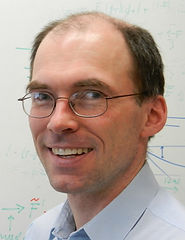achenu'at'dipc.org



SCHEDULE
OPENING REMARKS
9:15
Welcoming to Bilbao
SAHAR ALIPOUR (AALTO UNIVERSITY)
9:30
Dynamics of open quantum systems: Role of correlations (SLIDES)
Quantum correlation is a key element in quantum information science, believed to be responsible for a host of counterfactual effects in the quantum world. In this talk I will highlight the role of correlations in dynamics of open quantum systems and obtain a universal form for the dynamical equation in which correlations can be kept track of.
ALI REZAKHANI (SHARIF UNIVERSITY)
10:10
Detailed balance and fluctuation relations in quantum thermodynamics (SLIDES)
Quantum detailed balance conditions and quantum fluctuation relations are two important concepts in the dynamics of open quantum systems; both concern how such systems behave when they thermalize because of interaction with an environment. I show that for thermalizing quantum dynamics the quantum detailed balance conditions yield validity of a quantum fluctuation relation (where only forward-time dynamics is considered). This implies that to have such a quantum fluctuation relation (which in turn enables a precise formulation of the second law of thermodynamics for quantum systems) it suffices to fulfill the quantum detailed balance conditions. I, however, argue that the converse is not necessarily true; there exit cases of thermalizing dynamics which feature the quantum fluctuation relation without satisfying detailed balance.
-
10:50 - 11:30
Coffee time
AURELIA CHENU (DIPC)
11:30
Engineering Open Quantum Systems with fluctuating Hamiltonians (SLIDES)
We introduce a scheme for the quantum simulation of many-body decoherence based on the unitary evolution of a stochastic Hamiltonian. Modulating the strength of the interactions with stochastic processes, we show that the noise-averaged density matrix simulates an effectively open dynamics governed by k-body Lindblad operators. Markovian dynamics can be accessed with white-noise fluctuations; non- Markovian dynamics requires colored noise. The time scale governing the fidelity decay under many-body decoherence is shown to scale as N−2k with the system size N. Our proposal can be readily implemented in a variety of quantum platforms including optical lattices, superconducting circuits, and trapped ions.
ADOLFO DEL CAMPO (DIPC)
12:10
Monitoring quantum systems: speed limits and symmetry breaking (SLIDES)
In this talk we consider the continuous monitoring of quantum systems and elucidate the role of the measurement back action in quantum dynamics. Specifically, we consider the limits to the speed of evolution under continuous quantum measurements. The pace of evolution of physical systems is fundamentally constrained by quantum speed limits (QSL), which have found broad applications in quantum science and technology. It is shown that there are trajectories for which standard QSL are violated. We determine the dispersion of the speed of evolution and characterize the full statistics of single trajectories.
In a second part of the talk, we focus on spontaneous symmetry breaking (SSB), that is responsible for structure formation in scenarios ranging from condensed matter to cosmology. SSB is broadly understood in terms of perturbations to the Hamiltonian governing the dynamics or to the state of the system. Under continuous quantum measurements, the acquisition of information during the measurement process induces a measurement back-action that we identify as the crucial ingredient for SSB. An observer can thus tailor the topology of the vacuum manifold and the pattern of symmetry breaking by monitoring different observables.
-
12:50 - 14:30
LUNCH TIME
GEZA TOTH (UPV-EHU)
14:30
Quantum states with a positive partial transpose are useful for metrology (SLIDES)
We show that multipartite quantum states that have a positive partial transpose with respect to all bipartitions of the particles can outperform separable states in linear interferometers. We introduce a powerful iterative method to find such states. We present some examples for multipartite states and examine the scaling of the precision with the particle number. Some bipartite examples are also shown that possess an entanglement very robust to noise. We also discuss the relation of metrological usefulness to Bell inequality violation. We find that quantum states that do not violate any Bell inequality can outperform separable states metrologically. We present such states with a positive partial transpose, as well as with a non-positive positive partial transpose.
[1] Phys. Rev. Lett. 120, 020506 (2018)
GEZA GIEDKE (DIPC)
15:10 PM
Acoustic Traps and Lattices for Electrons in Semiconductors (SLIDES)
We propose and analyze a solid-state platform based on surface acoustic waves for trapping, cooling, and controlling (charged) particles, as well as the simulation of quantum many-body systems. We develop a general theoretical framework demonstrating the emergence of effective time-independent acoustic trapping potentials for particles in two- or one-dimensional structures. As our main example, we discuss in detail the generation and applications of a stationary, but movable, acoustic pseudolattice with lattice parameters that are reconfigurable in situ. We identify the relevant figures of merit, discuss potential experimental platforms for a faithful implementation of such an acoustic lattice, and provide estimates for typical system parameters. With a projected lattice spacing on the scale of ∼100 nm, this approach allows for relatively large energy scales in the realization of fermionic Hubbard models, with the ultimate prospect of entering the low-temperature, strong interaction regime. Experimental imperfections as well as readout schemes are discussed.
-
15:50 - 16:10
Coffee Break
LIAN-AO WU (UPV-EHU)
16:10
One Component Quantum Mechanics and a Universal Leakage Elimination Operator (SLIDES)
We use a Feshbach P-Q partitioning technique to derive a closed one-component integro-differential equation. The resultant equation properly traces the footprint of the target state in quantum control theory. The physical significance of the derived dynamical equation is illustrated by both general analysis and concrete examples. Leakage from an encoded subspace to the rest of the system space is a particularly serious problem for which leakage elimination operators (LEOs) were introduced. By using the resultant dynamical equation, we show that the effectiveness of LEOs depends on the integral of the pulse sequence in the time domain, which has been missing because of the idealization of pulse sequences. Our results are applied to adiabatic paths and a three- level system for the nitrogen-vacancy centers under an external magnetic field and are illustrated by the fidelity dynamics of LEO sequences, ranging from regular rectangular pulses, random pulses, and even disordered (noisy) pulses.
UWE FISCHER (SEOUL NATIONAL UNIVERSITY)
16:50
Experimental Quantum Cosmology:
Probing Analogue Trans-Planckian Physics in Dipolar Bose-Einstein Condensates (SLIDES)
1. We consider an analogue de Sitter cosmos in an expanding quasi-two-dimensional Bose-Einstein condensate with dominant dipole-dipole interactions between the atoms or molecules in the ultracold gas. It is demonstrated that a hallmark signature of inflationary cosmology, the scale invariance of the power spectrum of inflaton field correlations, experiences strong modifications when, at the initial stage of expansion, the excitation spectrum displays a roton minimum. Dipolar quantum gases thus furnish a viable laboratory tool to experimentally investigate, with well-defined and controllable initial conditions, whether primordial oscillation spectra deviating from Lorentz invariance at trans-Planckian momenta violate standard predictions of inflationary cosmology.
2. A rapid quench in the dipolar gas, performed on the speed of sound of excitations propagating on the condensate background, leads to the dynamical Casimir effect (and hence analogue cosmological particle production), which can be characterized by measuring the density-density correlation function. It is shown, for both zero and finite initial temperatures, that the continuous-variable bipartite quantum state of the created quasiparticle pairs with opposite momenta, resulting from the quench, displays an enhanced potential for the presence of entanglement (represented by nonseparable and steerable quasiparticle states), when compared to a gas with solely repulsive contact interactions. Steerable quasiparticle pairs contain momenta from close to the roton, and hence quantum correlations significantly increase in the presence of a deep roton minimum.
References
1. Seok-Yeong Chä and Uwe R. Fischer: Probing the scale invariance of the inflationary power spectrum in expanding quasi-two-dimensional dipolar condensates, Phys. Rev. Lett. 118, 130404 (2017).
2. Zehua Tian, Seok-Yeong Chä, and Uwe R. Fischer: Roton entanglement in quenched dipolar Bose-Einstein condensates, Phys. Rev. A 97, 063611 (2018).
SPEAKERS
Confirmed Speakers

SAHAR ALIPOUR
Aalto University

AURELIA
CHENU
DIPC

ADOLFO
DEL CAMPO
DIPC

UWE R. FISCHER
Seoul National University

GEZA GIEDKE
DIPC

ALI REZAKHANI
Sharif University

GEZA TOTH
UPV-EHU

LIANAO WU
UPV-EHU

ORGANIZERS
Ikerbasque Research Fellow
Ikerbasque Research Professor



